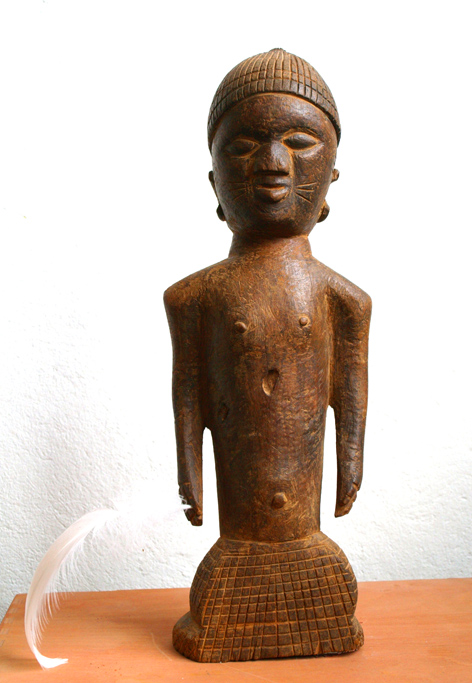 Flamingo Man (Ralf Kwaaknijd in collaboration with unknown Nigerian artist; 45 x 10 x 10 cm, wood & flamingo feather, 2009)
Flamingo Man (Ralf Kwaaknijd in collaboration with unknown Nigerian artist; 45 x 10 x 10 cm, wood & flamingo feather, 2009)I sold the above Flamingo Man to a friend, at a friend's price to help inspire him in his new studio.
I had to explain it to him, though, because he first questioned me about it, thinking it to be "Art appropriation taken too far, an extra theft, on top of the already physical theft of an enormous amount of african art by western collectors. And in fact a theft of a worse kind. Because you also claim the artistic credit, one would say the one inappropriatable element left the original artist."
So let me post my reply here:
Dear Frank, you still don't get it do you? Flamingo man is precisely a statement about the theft of art from the `primitive' cultures - so `primitive' that Picasso, Giacometti, you name it, all took their forms and ideas and became famous with them.
Apart from the purely visual beauty of Flamingo Man (you will have to admit that the feather is transformative!) I wished to demonstrate that one can steal easily from the unknown `tribal' artist. (S)he cannot protect her/himself. One buys a sculpture, and the material possession opens up a can of worms of artist's rights' infringements.
Perhaps you will recall the utterly shaming history of the song the lion sleeps tonight? Please look it up to see what I mean (I even saw an American performer claiming it as his own in some historic footage, but I don't recall precisely where).
Yet, Flamingo Man can actually help by drawing attention to this, I feel. So yes, you are right, appropriation a step too far, that is precisely the idea. But I do not wish to profit from it. And since I appreciate you taking the time to really reflect on my work, if you wish I will sell it to you for the price that I paid for the sculpture, the flamingo feather you get for free.
This way you can own a real Kwaaknijd, and maybe reappropriate it!
Kind regards, Ralf
(What is art appropriation? Wikipedia:
In the [(visual arts)], to appropriate something means adopting, borrowing, recycling or sampling aspects (or the entire form) of man made visual culture. The Oxford English Dictionary defines appropriation in relation to art as 'the practice or technique of reworking the images or styles contained in earlier works of art, esp. (in later use) in order to provoke critical re-evaluation of well-known pieces by presenting them in new contexts, or to challenge notions of individual creativity or authenticity in art.". The term appropriation refers to the use of borrowed elements in the creation of a new work (as in 'the artist uses appropriation') or refers to the new work itself (as in 'this is a piece of appropriation art'). The artist who uses appropriation may borrow image, sound, objects, forms or styles from art history or [(popular culture)] or other aspects of man made visual culture. Inherent in the process of appropriation is the fact that the new work recontextualizes whatever it borrows to create the new work. In most cases the original 'thing' remains accessible as the original, without change.)











